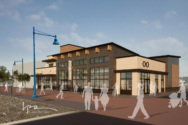
Home » BPA’s plans aim to support growing Tri-Cities’ economy
Bonneville Power Administration
BPA’s plans aim to support growing Tri-Cities’ economy

December 13, 2024
The Bonneville Power Administration is working hard to meet the needs of residents and businesses in and around the Tri-Cities. By supplying utilities with clean, low-cost hydropower and nuclear energy over a reliable high-voltage transmission system, our aim is to drive the Northwest’s economic prosperity and environmental sustainability.
In Washington, BPA delivers this federal power to consumer-owned utilities – including Benton Public Utility District, Benton Rural Electric Association, Franklin PUD, the city of Richland and Columbia REA – which collectively consume more power from the Federal Columbia River Power System than any other state in the region.
With winter upon us, BPA is reminded of the challenges that extreme weather or low water conditions can pose to the communities we serve. Last January, the arctic blast that battered the Pacific Northwest tested the federal power and transmission system. But with careful planning and a rapid, coordinated response, BPA weathered the storm.
The federal dams and Columbia Generating Station, the region’s only nuclear plant, were vital to keeping the lights on. Through close coordination with our counterparts at the U.S. Army Corps of Engineers, the Bureau of Reclamation and Energy Northwest, we maintained reliable operations while avoiding major power interruptions.
Since then, BPA has worked to ensure operations run unhindered once again. With an increased focus on transmission expansion, generation maintenance and system performance improvements, BPA is prepared to keep the lights on for the Tri-Cities and the broader region.
Improved transmission
BPA is working on several major transmission projects to support the growing need for power in the Tri-Cities area.
This year we completed a new 500-kilovolt capacitor bank in Benton County, supporting more than 800 megawatts of new transmission service requests and relieving transmission constraints.
We’re also moving forward with the Tri-Cities Reinforcement Project to significantly increase the amount of electricity that can flow into the local area.
This portfolio of work consists of three power line upgrades, a suite of fiber and substation reinforcements, and a proposed new 115-kilovolt line called the South of Tri-Cities Reinforcement.
BPA is currently assessing the environmental impacts of the new line and considering public input. Following the release of a draft environmental assessment in early 2025, BPA will hold a final public meeting to deliver the findings and seek further input before deciding whether to build.
Maintaining power reliability
BPA continues to maintain and improve the performance of the region’s valuable federal hydropower assets while making investments that benefit salmon. This includes work at Ice Harbor and McNary dams, operated by the Corps, which are essential to the delivery of dependable, carbon-free hydropower throughout Washington.
At Ice Harbor, BPA is finishing the installation of three new turbines that are replacing the dam’s original turbines. The new turbines were designed to improve fish passage and a propellor-type turbine will significantly reduce potential oil releases.
We also continue to make investments and upgrades that benefit salmon. At McNary, BPA is working on replacing the dam’s 14 adjustable blade turbines with a new combination of adjustable blade turbines and propeller turbines. Similar to Ice Harbor, this combination will improve overall fish passage at the dam and greatly decrease the potential of oil releases to the river.

BPA continues to maintain and improve the performance of the region’s valuable federal hydropower assets while making investments that benefit salmon. This includes work at Ice Harbor and McNary dams, operated by the Corps, which are essential to the delivery of dependable, carbon-free hydropower throughout Washington.
|Courtesy BPA
Mitigating the impacts
As BPA continues to enhance its ability to deliver hydropower to the region, it is also bolstering efforts to mitigate the effects of the federal hydropower system on local fish and wildlife. BPA funds hundreds of actions every year in support of efforts to restore fish and wildlife habitats throughout the Columbia River Basin. We routinely monitor and evaluate the effects of these actions to ensure we are investing in effective and proven measures.
This is clearly an era of great progress for BPA-funded efforts to mitigate the impacts of the federal dams on salmon and steelhead and broader federal efforts to increase their abundance.
This year, more than 1.7 million salmon and steelhead passed Bonneville Dam. The Independent Science Advisory Board acknowledged that the region is moving closer to the Northwest Power and Conservation Council’s goal of returning 5 million salmon and steelhead to the Columbia and Snake rivers by 2025, if you count the fish that enter tributaries before reaching and being counted at Bonneville Dam and those harvested before reaching the dam.
A highlight of our mitigation efforts in the Tri-Cities area, BPA funded a river and floodplain restoration project led by the Confederated Tribes of the Umatilla Indian Reservation and the Snake River Salmon Recovery Board. Completed last year, the three-year project enhanced approximately a mile of privately-owned agricultural land along the Tucannon River.
The project improved spawning and rearing habitats for threatened or endangered Snake River Chinook salmon and steelhead as well as other species. The Tucannon watershed supports the remaining population of spring Chinook in the lower Snake River. The project also reconstructed the river channel to establish floodplain connection and constructed log jams in the channel to provide habitat complexity.
Supporting economy
BPA will continue partnering with local utilities and others in the area to ensure we deliver reliable, cost-effective power and transmission services. Our aim is to support your growing economy while sustaining the natural resources and world-class recreation that make the Tri-Cities such a desirable place to live and visit.
John Hairston is BPA’s administrator and chief executive officer.
Latest News Local News Energy Opinion
KEYWORDS December 2024
Related Articles
Related Products




